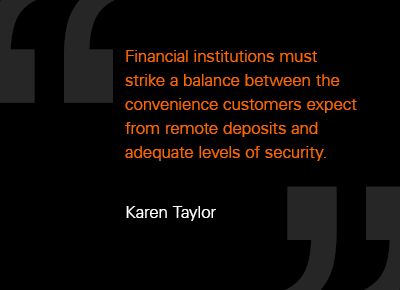

The Point
Reducing Risk and Enhancing Product Capabilities for Mobile Remote Deposit Capture: Three Key Capabilities
Mobile deposit capture continues to grow in usage, with more than 17.4 million U.S. online households using the capability in 2015 – up 13 percent year over year, according to the Expectations and Experiences Payments Survey from Fiserv. The demand for mobile remote deposit capture is a major opportunity to win new customers, but increased usage can also increase fraud risks.
Checks have long been a favorite target for fraud, and mobile deposits add a new risk of unintentional or fraudulent duplicate deposits. Financial institutions must strike a balance between the convenience customers expect from remote deposits and adequate levels of security. Mobile deposit transaction limits and delayed availability of deposited funds add layers of security, but these measures make remote deposit capture less convenient, discouraging usage. Manual monitoring can be marginally effective, but the process places a heavy burden on operational costs.
To protect themselves and their customers – and differentiate their product offerings – financial institutions need to adopt an automated risk-based approach to real-time monitoring of remote deposit and leverage advanced analytics and flexible limits.
As a result, many financial institutions are turning to fraud monitoring technology, which is changing how banks fight check fraud. To help pinpoint anomalies, technology solutions can provide a real-time, comprehensive view of mobile deposit capture deposits – and fast, safe and personalized service for customers.
Three capabilities are essential to the successful delivery of risk-based mobile deposit capture services.
Data Analytics
Data analytics techniques and predictive models help financial institutions assess and manage risk, making it possible to analyze every aspect of a mobile deposit capture transaction and give it an appropriate risk score. Financial institutions can use this information to implement customer-centric safeguards, such as tiered deposit limits for different customer segments and accelerated funds availability for low-risk customers. Such segmentation brings value to a financial institution's most important customers.
Real-Time Capabilities
Real-time detection of fraud enables financial institutions to quickly identify and stop potentially fraudulent deposits. Alerts can be sent in real time to fraud investigators based on the bank's risk threshold. In the same way, real-time automated actions, such as placing a hold on a deposit, can help keep customers informed and accounts protected.
A Layered Approach
A multilayered approach to transaction monitoring and fraud prevention includes sophisticated analytics with predictive models, scorecards and decision trees. In addition, processes should include automated responses that suspend suspicious transactions immediately, alerting and workflows to flag potential fraud, and trend analysis and reporting.
When offering remote deposit capture, achieving the right balance between fraud prevention and customer experience will always a balancing act. Technologies that analyze transaction, customer and institutional data make it possible to clear good checks in real time, quickly block potential fraud and ultimately provide customers with anytime, anywhere remote deposits.
Read Mobile Remote Deposit Capture: Balancing Fraud Prevention and Customer Convenience to learn more about balancing fraud prevention with growing customer expectations.
